Fabric products of Southeast Asian nations are of similarities and differences
DOI:
https://doi.org/10.51453/2354-1431/2018/231Keywords:
Handmad; weave, embroider; linen, Southeast Asia; Batik;Ikat.Abstract
Weaving in Southeast Asian countries has been a traditional handicraft with a long
history. With the plentiful and diverse types and colors, reaching the level of
sophistication, their textile / fabric products have contributed to the national identity of each country in the region.
Fabric products of ethnic groups in Southeast Asian countries have many
similarities, difference. The similarities and differences in fabric products are also an
indication of the cultural unity and diversity of Southeast Asia, which is basically
based on a common cultural background. In other words, features of fabric products
in each country contribute to the unity, while individual features / nuances of each
country contribute to the diversity of Southeast Asia.
Currently, in addition to meeting the demands of each country, many beautiful batik and ikat products which are well-known with a variety of new models of Southeast Asia are now present in many countries around the world and favored by customers. This is also the reason why Southeast Asia has been evaluated as one of the areas possessing beautiful handmade fabric product which are worldwide famous by researchers. However, moving along with the process of integration and globalization, fabric products of Southeast Asian countries are also facing many challenges of conservation and development.
Downloads
References
1. Maxwell, Robyn, Textiles of South-East Asia: Tradition, Trade and Transformatin. Melbourn, Australia National Gallery, 1990.
2. Leedom Lefferts, Textiles and Tai experience in Southeast Asia. Washington DC,1992.
3. Michael. C.Howard, Kim Be. Howard. Textiles of Southeast Asia: An Anotated & lllustrated Bibliography.BangKok White Lotus Press, 1994.
4. Fiona Kerlogue, The book of Batik. Archipelago Press, Singapore, 2004.
5. Nhiều tác giả, Đồ vải của người Thái ở tiểu vùng sông Mê Công: tiếp nối và biến đổi (Việt, Anh).Bảo tàng Dân tộc học Việt Nam, H, 2006.
6. Michael. C.Howard, Bark-cloth in Southeast Asia (editor). Bangkok: White Lotus Press, 2006.
7. Michael.C.Howard, A World Between the Warps: Southeast Asia’s Supplementary Warp Textiles. Bangkok: White Lotus Press, 2008.
8. Nhiều tác giả, Catalogue Văn hóa Đông Nam Á (Việt, Anh, Pháp). Bảo tàng Dân tộc học Việt Nam, H, 2010.
Downloads
Published
How to Cite
Issue
Section
License

This work is licensed under a Creative Commons Attribution-ShareAlike 4.0 International License.
All articles published in SJTTU are licensed under a Creative Commons Attribution-ShareAlike 4.0 International (CC BY-SA) license. This means anyone is free to copy, transform, or redistribute articles for any lawful purpose in any medium, provided they give appropriate attribution to the original author(s) and SJTTU, link to the license, indicate if changes were made, and redistribute any derivative work under the same license.
Copyright on articles is retained by the respective author(s), without restrictions. A non-exclusive license is granted to SJTTU to publish the article and identify itself as its original publisher, along with the commercial right to include the article in a hardcopy issue for sale to libraries and individuals.
Although the conditions of the CC BY-SA license don't apply to authors (as the copyright holder of your article, you have no restrictions on your rights), by submitting to SJTTU, authors recognize the rights of readers, and must grant any third party the right to use their article to the extent provided by the license.





